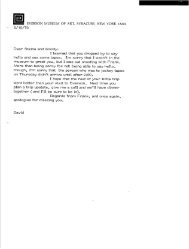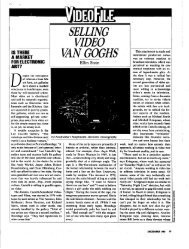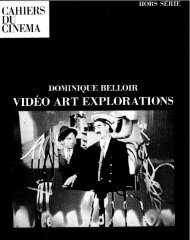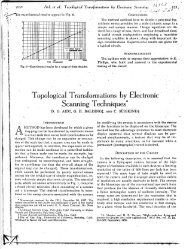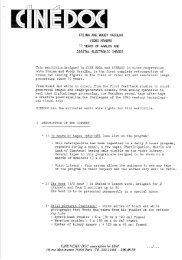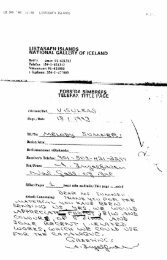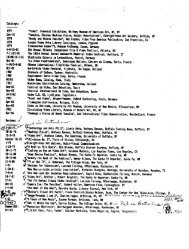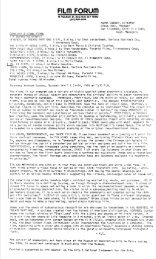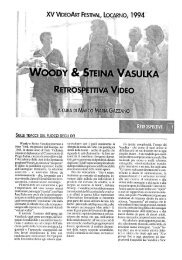MEDIA STUDY/BUFFALO - the Vasulkas
MEDIA STUDY/BUFFALO - the Vasulkas
MEDIA STUDY/BUFFALO - the Vasulkas
You also want an ePaper? Increase the reach of your titles
YUMPU automatically turns print PDFs into web optimized ePapers that Google loves.
March 24 (Saturday)<br />
8 :00 PM<br />
The Historical Society<br />
QUEEN KELLY (1928)<br />
Directed by Erich von Stroheim . With<br />
Gloria Swanson, Walter Byron, Seena<br />
Owen and Tully Marshall . Black and<br />
White . 96 minutes . Silent with live musical<br />
accompaniment .<br />
Halted by its producers (Joseph Kennedy<br />
and Gloria Swanson) while it was<br />
still in shooting, Queen Kelly was Erich<br />
von Stroheim's final silent film and his<br />
last major project as a motion picture<br />
director. Stroheim had been approached<br />
by Swanson and Kennedy<br />
(<strong>the</strong>n at <strong>the</strong> helm of a Hollywood conglomerate<br />
that included RKO) to write<br />
and direct a follow-up to Swanson's<br />
successful, independently produced<br />
Sadie Thompson . What <strong>the</strong> notorious<br />
director proposed was a work of epic<br />
proportions based on his own story<br />
(The Swamp) about a young convent<br />
girl who is seduced by a prince, saved<br />
from suicide, shipped to an ailing aunt<br />
who runs a bordello in Africa, married<br />
off to a depraved white planter, and finally<br />
reunited with her prince .<br />
Following approval by <strong>the</strong> Hays<br />
Office which, among o<strong>the</strong>r things, had<br />
Stroheim transform <strong>the</strong> bro<strong>the</strong>l into a<br />
hotel, <strong>the</strong> production began and<br />
proceeded with complete equanimity<br />
between star and director. However, as<br />
March 31 (Saturday)<br />
8:00 PM<br />
The Historical Society<br />
a<br />
WARY OF A LOST GIRL<br />
(1929)<br />
(Das Tagebuch Einer Verlorenen)<br />
Directed by G . W. Pabst . With I-ouise<br />
Brooks, Josef Rovensky, Fritz Rasp<br />
and Vera Pavlova . Black and White.<br />
100 minutes . Silent with live musical<br />
accompaniment .<br />
Only recently restored and revived, Diary<br />
of a Lost Girlwas American actress<br />
Louise Brooks's second film for German<br />
director G . W Pabst . While still<br />
under contract to Paramount's Long Island<br />
studio where she had performed<br />
minor roles in even more minor productions,<br />
Brooks had been selected by<br />
Pabst to star in a major adaptation of<br />
Wedekind's Pandora's Box. She was to<br />
play Lulu, <strong>the</strong> savage innocent, whose<br />
free-spirited, libidinous persona<br />
brought unprecedented chaos into <strong>the</strong><br />
staid lives of <strong>the</strong> German uppercrust .<br />
Under <strong>the</strong> skillful eye of Pabst, Brooks<br />
created not only her finest role, but one<br />
of <strong>the</strong> most stunning performances of<br />
<strong>the</strong> silent period .<br />
Made <strong>the</strong> year after Pandora's Box,<br />
Pabst's Diary of a Lost Girl was an<br />
adaptation of a popular novel by Margarete<br />
Bohme. Brooks is here cast as<br />
Thymian, <strong>the</strong> headstrong daughter of<br />
a wealthy pharmacist, who is seduced<br />
by her fa<strong>the</strong>r's assistant and <strong>the</strong>n inextricably<br />
led into a sordid life of reform<br />
schools and bro<strong>the</strong>ls . Noted for its<br />
ra<strong>the</strong>r frank, graphic portrayal of Thymian's<br />
downfall, Diary ofa Lost Girl, like<br />
Pandora's Box before it, was mutilated<br />
by <strong>the</strong> censors in America and even<br />
in Germany. The print for this screening<br />
includes a partial restoration of<br />
much of this previously lost material .<br />
<strong>the</strong> shooting moved into <strong>the</strong> African sequences,<br />
Swanson noticed that scenes<br />
deleted by <strong>the</strong> Hays Office began to<br />
reappear in <strong>the</strong> production . Fearful of<br />
censorship and infuriated by <strong>the</strong> fact<br />
that Stroheim was spending "a<br />
fortune-of my money-shooting stuff<br />
he knew perfectly well would never get<br />
into <strong>the</strong> finished picture," Swanson<br />
consulted with Kennedy, who advised<br />
terminating <strong>the</strong> project . Swanson fired<br />
Stroheim and shelved <strong>the</strong> unfinished<br />
film to work on her first talkie, eventually<br />
tacking on a trite ending (supposedly<br />
directed by MGM boss Irving<br />
Thalberg) to an abridged version of<br />
Queen Kelly, and releasing <strong>the</strong> film in<br />
Europe and South America in <strong>the</strong> early<br />
thirties. While Swanson was never<br />
able to release <strong>the</strong> film in this country,<br />
in a memorable sequence from Billy<br />
Wilder's Sunset Boulevard (1950),<br />
Swanson, as Norma Desmond,<br />
screens a clip from Queen Kelly for William<br />
Holden .<br />
Even in its truncated version, Queen<br />
Kelly reveals <strong>the</strong> brilliance of <strong>the</strong> Stroheim<br />
style that combined striking deepfocus<br />
cinematography with, exuberant<br />
acting and elaborate set design . Our<br />
program will include <strong>the</strong> Swanson version<br />
of Queen Kelly followed by two<br />
reels of outtake sequences . including<br />
<strong>the</strong> infamous African bro<strong>the</strong>l footage .<br />
The sublime actress Louise Brooks . Photo : MOMA Film Stills Archive.<br />
Director Erich von Stroheim . Photo : MOMA Film Stills Archive.<br />
25



